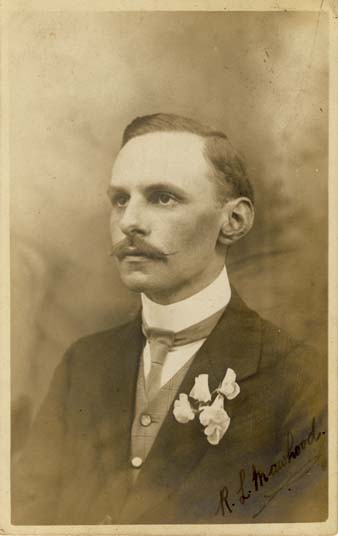The Rapid Art Photography (R. A. P.) company was established around 1907 by a photographer named De Jornette Plummer. Previously, De Jornette Plummer had worked as a photographer on Brighton's Palace Pier and had produced photographic picture postcards imprinted with the name "American Art Rapid Photography". De Jornette Plummer had probably arrived in England from the continent around 1901. [ I cannot trace De Jornette Plummer in the English census returns produced between 1861 and 1901]. In 1902, in the London district of Marylebone, De Jornette Plummer married Madame Hortense Loretz (formerly Hortense Sober). [The marriage of De Jornette Plummer and Hortense Loretz was registered in the London district Marylebone during the 2nd Quarter of 1902]. De Jornette Plummer's wife was born Hortense Sober in the Belgian city of Brussels around 1864. At the age of eighteen, Hortense Sober (born c1864, Brussels, Belgium) had married Carl Prosper Loretz. [The marriage of Carl Prosper Loretz and Hortense Sober was registered in the Strand district of London during the 2nd Quarter of 1881]. Twenty years later, Madame Loretz was free to marry again. Madame Hortense Loretz, then in her late thirties, married De Jornette Plummer, who was at that time conducting experiments in photography. In the early 1900s, De Jornette Plummer was based at 43 Southampton Buildings, Chancery Lane, London. In 1903, the trade journal "The Photographic Dealer" reported that De Jornette Plummer had introduced "a new or improved photographic or printing frame". By 1903, De Jornette Plummer had set up a photographic stall on Brighton's Palace Pier, where he took souvenir portraits of holiday makers which were presented in the recently introduced "picture postcard" format. De Jornette Plummer was producing picture postcards before the "divided back" had taken off commercially. (Until January 1902, postal regulations stipulated that one side of the picture postcard had to be reserved for the postage stamp and the name and address of the recipient and therefore any messages had to be written on the picture side of the photograph). The early souvenir photographic portraits produced at Plummer's photographic stall on Brighton's Palace Pier, occupied less than half the surface area of the "picture side" of the postcard. The majority of the space on the "picture side" was left clear to allow the sender to write a message to the recipient of the postcard. However, by 1904, De Jornette Plummer was producing picture postcards with "divided backs", so that the whole of one side of the card could be covered by a photographic print. Plummer's early picture postcards carried the picture credit "Brighton Palace Pier - American Art Rapid Photography", but by 1907, De Jornette Plummer had established a company called Rapid Art Photography (R. A. P.) Galleries, setting up branches in Brighton, Hastings and Eastbourne.
De Jornette Plummer opened the Brighton branch of Rapid Art Photography (R. A. P.) Galleries at 59 King's Road, Brighton around 1907. Shortly afterwards, D. J. Plummer recruited the German-born photographer Hans D. Prochnow (born c1880) to manage the Eastbourne branch of Rapid Art Photography (R. A. P.) at 56c Terminus Road, Eastbourne. During the same year, D. J. Plummer opened R. A. P. galleries in Hastings, Bournemouth and Southsea. Around 1910, De Jornette Plummer arranged for his wife, Madame Hortense Plummer (born 1864, Brussels, Belgium) to manage the R. A. P. Gallery at 28 White Rock, Hastings.
The Rapid Art Photography (R. A. P.) Galleries appear to have closed in 1919 with the death of Madame Hortense Plummer, the wife of the company's founder De Jornette Plummer. [The death of Hortense Plummer was registered in the district of Hastings during the 1st Quarter of 1919]. Madame Hortense Plummer's R. A. P. studio at 28 White Rock, Hastings was last listed in the 1918 edition of Kelly's "Directory of Sussex". A year or so after his wife's death, De Jornette Plummer married Edith Mary Metters (born 1890, Hampstead, London), a professional photographer and the daughter of Caroline and John Metters, a warder at Wandsworth Prison. [The marriage of De Jornette Plummer and Edith M. Metters was registered in the St Pancras district of London during the 3rd Quarter of 1920]. It is possible that De Jornette Plummer and Edith Mary Metters were living as man and wife before the death of Madame Hortense Plummer in 1919. A photographer named "Mrs Edith Plummer" appears in Liverpool trade directories published between 1917 and 1920 with studios at 35 Moorfields, Liverpool and 95 West Derby Road, Liverpool. Presumably, De Jornette Plummer and Miss Edith M Metters had to wait for the death of Plummer's first wife before marrying in 1920. After their marriage, De Jornette Plummer and his new wife returned to Liverpool, where they established a new photographic business - Princess Dubarries Portrait Studios Limited. According to The British Journal of Photography, on 6th May 1921, the private company of Princess Dubarries Portrait Studios Ltd. was registered "to carry on the business of photographers and photographic artists, dealers in photographic goods, apparatus, chemicals and materials, etc." The directors of the Princess Dubarries Portrait Studios were given as Mrs Edith Plummer and De Jornette Plummer of 103 Bedford Street South, Liverpool. It seems that De Jornette Plummer disappeared from the scene before 1924. De Jornette Plummer might have died or simply abandoned his wife. In 1922, The British Journal of Photography reporting on Plummer's photographic business, states that Mrs Edith Plummer of 103 Bedford Street South, Liverpool, was "the sole director for life". On 25th September 1922, at an Extraordinary Meeting of the Shareholders of the Princess Dubarries Portrait Studios Ltd. it was proposed "that the Company be wound up voluntarily". Mrs Edith Plummer died in Hampstead, London in 1946, aged 56. [The death of Edith M. Plummer was registered in the North London district of Hampstead during the 3rd Quarter of 1946]. I have not traced a record of the death of De Jornette Plummer in English death registrations, so he might have returned to Europe during the 1920s. |
|






























































